Before pens and pencils were introduced from the West, brushes were the most common tools for writing and painting in East Asia. Thus, brush making was an important occupation that required a great deal of skill and experience. Adhering to the painstaking old ways of brush making instead of enjoying the ease and efficiency of modern processes, the master brush maker Yu Pil-mu says he pours his life into his work.
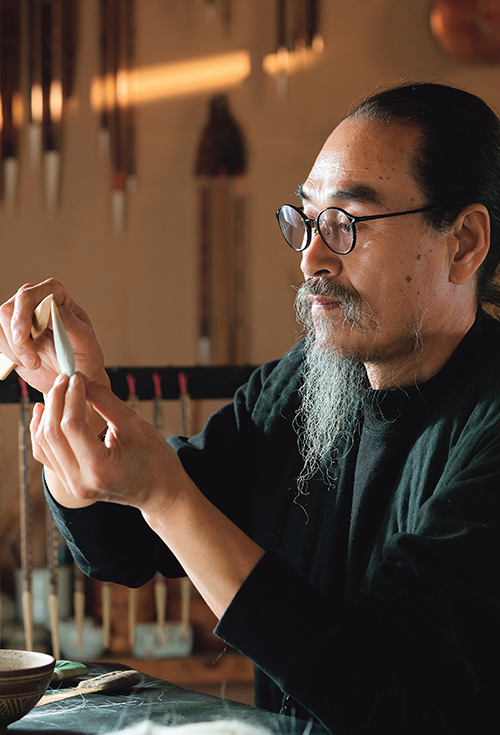
The master brush maker Yu Pil-mu checks a white goat hair brush to see if it has a fine point tip. He considers that the essential part of his work is to produce brushes with no spines, made of high-quality natural hair of the same kind from the outside to the core.
Whenever a novice calligrapher came to him for a brush and he sold one with some hesitation, he always ended up regretting it. Before long, the buyer would call him and tell him in a grave voice that all his colleagues, even his teacher, had commented that it was a “poorly bound” brush. This is the main reason the master brush maker Yu Pil-mu has decided to turn away most of the people who ask to buy his brushes.
Yu makes a clear distinction between his handcrafted brushes and those sold at shops for calligraphy supplies. “I can assure you that 99 percent of the brushes on the market have nylon bristles mixed with animal hair. Those brushes usually have a core, or a spine, made of stiff synthetic hairs, which makes it easy for anyone to quickly learn to control them,” Yu said, adding, “Anyone used to those brushes would be perplexed by mine.”
Brush with No Spine
A brush with the core strengthened by stiff hairs, either synthetic or natural, has firm bristles. Such a brush is easy to control but tends to make uncharacteristic, monotonous strokes. Strong, stiff animal hairs are not an inferior material in themselves. Some brushes are made of stiff hairs from the tail of a weasel or a horse, others with soft goat hair or chicken feathers, and still others have a core of stiff hairs surrounded by an outerof soft ones.
In some cases, as many as 15 different kinds of hair are combined to make a single brush. It is just a matter of choice that depends on the user’s purpose and preferences. That said, the master brush maker raised the issue of the degradation of standards for calligraphy brushes and the flagging efforts to preserve the craft of traditional brush making in its original form and hand it down to future generations.
“If I didn’t have to worry about making a living, I wouldn’t want to sell any of them.”
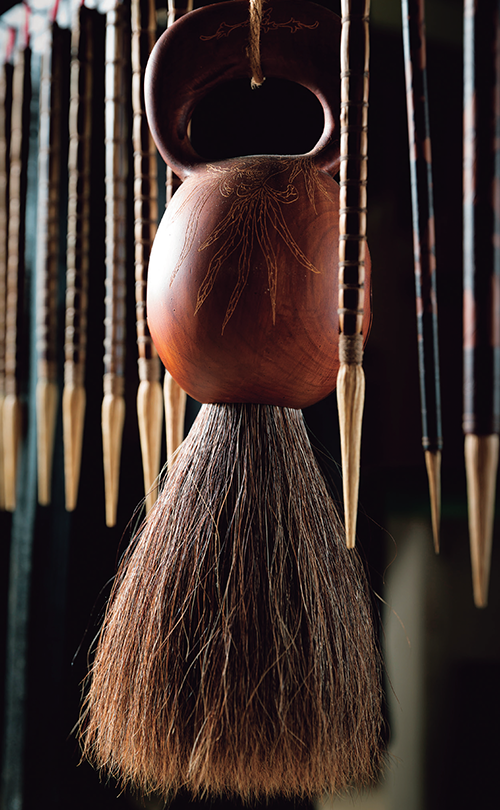
The brush combined with the Buddhist monk’s wooden block is the outcome of 10 years of research. From making brush heads, Yu expanded his specialty to brush handles as well in order to take charge of the entire brush making process.
The essential part of his work, Yu noted, is to produce “brushes with no spine,” or musimpil, the epitome of traditional Korean calligraphy brushes. These spineless brushes are made of high-quality natural hair of the same kind from the outside to the core.
“From old times, the spineless brush has been most highly regarded by calligraphers,” he explained. “With this brush, even the most proficient calligraphers would have difficulties making simple lines unless they had used it for a while to get fully acquainted with it. With no stiff core to support the bristles, it is hard to control. On the other hand, being delicate, soft and supple, the brush often produces unintended s, creating a boundless variety of effects. The softest is the strongest, as the old saying goes.”
During the 40 years devoted to his craft, Yu has developed uncommon insight into brush hairs. He pointed out that all animal hairs could be used for making brushes. Back when brushes were the only writing tool, they were made of any natural hairs available - the hair of weasels, rabbits, pigs, roe deer, chickens, and even newborn babies. However, human hair can’t be used after the first haircut, which blunts the ends, since the pointy ends need to be intact for brushes.
Currently, one of the most popular materials for brushes is white goat hair. The goat provides hairs of varied length and texture, suitable for a wide range of brushes. The hairs from the goat’s back and heels and even whiskers can all be used separately to make different kinds of brushes.
Yu likes to use the hair from the inner hind legs. “See how the hair grows brighter and more transparent toward the end, tapering to a delicate tip?” he said, holding up a patch of goat hide with the hair still attached.
He went on to explain, “The coloring indicates a dense internal structure. Then, what does it look like at the root, closer to the hide? It grows opaque and white, doesn’t it? That means the structure is less dense. The hair gets weaker and more apt to break toward the root. But most brush makers use this part as well so they can make bigger brushes and charge more for them. But I usually cut away a large portion of the root part, and sometimes push the clipped end almost three centimeters deep into the ferrule that connects the bristles and the handle. I do this simply to extend the life of the brushes.”
“Other artisans might call me crazy,” Yu said, with a smile. “I doubt that my efforts are appreciated. But I just can’t stop, because I believe I’m doing a worthwhile thing.”
Adhering to Traditional Techniques
Dealing with animal hairs is hard work. It usually takes more than five years just to master the skills for collecting raw hairs from animal hides, Yu said. Yu does not grudge the long time spent preparing the hairs, a time that seems to vanish at his fingertips. The next step is removing oil from the hairs before they are tied in bunches, which is also very time-consuming. Oil left on the hairs forms a barrier that prevents the ink from fully soaking in. For this important procedure to help control the flow of ink, he follows the old ways: sprinkling the hairs with ashes from burnt rice husks, covering them with mulberry paper, and pressing them with stone fulling blocks for a year to remove the oil. Hairs with higher oil content, such as weasel hair, horse tail hair and cow’s ear hair, are buried near the front gate of the house so that they will be trodden on frequently by people coming and going.
“For the last 20 years, I’ve doggedly stuck to the old method, handed down orally from at least four generations ago,” Yu said. “But most other artisans use heat treatment for oil removal, pressing a thick, heated steel plate on piles of hairs. This removes oil in less than 10 minutes, but the hairs are so damaged that they tend to crumble and fall out of the brush head. Yet, no one has called this method into question.”
Having committed himself to reviving the disappearing tradition of brush making, Yu started to re brushes using plant fibers instead of animal hairs. In the distant past, plant fiber brushes were a substitute for those made with more expensive animal hair. An example is the brush made with kudzu roots, which have some of the softness of sheep’s wool but are better at expressing the shredded lines of the “flying white” (baekbi, or feibai in Chinese) style of calligraphy. After successfully recreating the kudzu root brush in the early 1990s, he began to use dozens of other plants, such as silver grass, blood grass and palm tree bark. In brush making, while the process of preparing animal hairs can be summed up as discarding and sorting out, preparing plant fibers is all about pounding, which requires a great deal of time and effort.
“The fibers have to be split into fine threads. In my experience, the only way to do this is to keep on pounding, around 5,000 to 50,000 times, to remove all starch and sap and leave only the fibers,” Yu explained. “But it has to be done lightly, because striking them too hard would ruin the fibers. As for kudzu roots, it takes about three months just to process them into threads.”
With no books or written sources to refer to, Yu sought out all the oral tradition available about the techniques and studied them on his own, asking himself what he would have done if he had lived 300 or 500 years ago.
“Our ancestors must have been very wise; everyone was an engineer and a scientist,” he observed. “Without today’s advanced scientific equipment, they knew everything they had to know. I feel that retracing their footsteps is my calling in this world.”
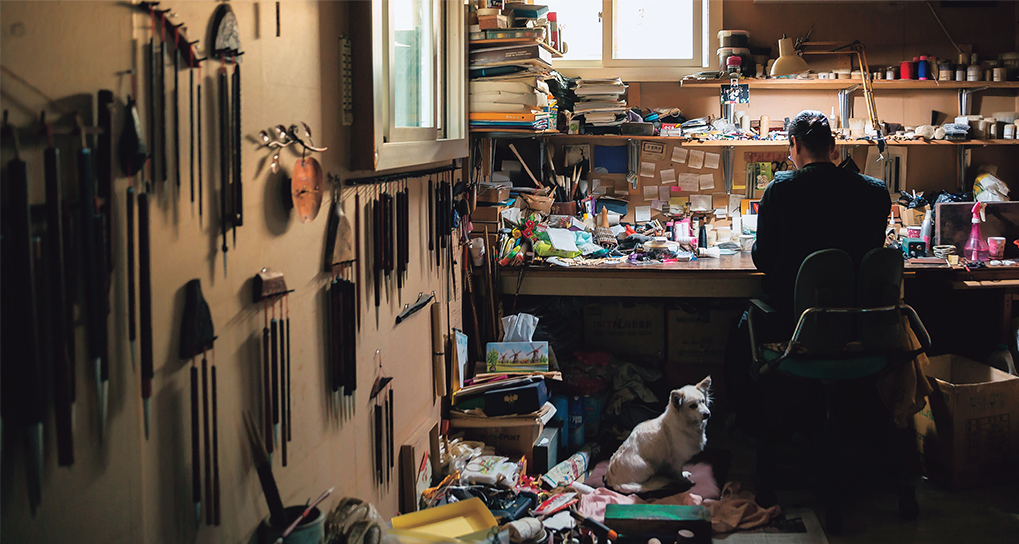
Yu’s workshop in Jeungpyeong County, North Chungcheong Province, has been provided by a patron free of charge since 2010. After securing a stable place to work, he was able to fully dedicate himself to studying traditional brushes.
Staying Faithful to the Basics
After losing his father at age 10, Yu left his hometown, Chungju, at 13 to go to Seoul, where he worked at a number of restaurants and factories. In 1976, when he was working at a wig factory, taking stimulants to stay awake at night to work longer, a relative recommended him for a job at a brush-making workshop. He now laughs away the hard times, describing his life back then as being “haunted by hairy ghosts.” But as a young man he was happy to leave the wig factory for a “dignified job” of making art tools. On average, he worked 15 hours a day, devoting almost all his waking hours to making a living. At times he almost gave up, but he managed to stay at the workshop for 12 years mastering his skills, and then set up his own workshop to make his own brushes.
In the early 1990s, just when he thought he could manage to get by with his craft, Korea established diplomatic relations with China, opening the doors for cheap and inferior Chinese products which would soon engulf calligraphy supplies stores nationwide. To compete with the Chinese brushes, the quality standards of domestic products were lowered. The situation has not changed for almost 30 years. A determination to hold on to the basics was what helped Yu persevere through the tough times. To stay faithful to the basics, he has been strict on himself and his work. Last year, his brush-making craftsmanship was named an important intangible cultural property of his home province, North Chungcheong, the first official recognition of his lifelong endeavor.
“A good brush has four virtues: bristles firm and flexible in the middle; the brush head packed tight and round at the ferrule; hairs that spread out evenly on the paper; the tapering tip that holds a fine point,” Yu explained. “Most artisans agree that a good brush, however large, can also be used for the finest lines. In the old days, the level of refinement in calligraphy was shown in whether one could use the same brush for both the big characters of a text as well as the small ones in the signature section. Virtuous scholars, or seonbi, felt that it was undignified to change brushes in a single work. From this we can deduce that when a brush can no longer be used for the small letters it should be replaced.”
Yu is merciless in criticizing brushes that fall short of the basic requirements. He simply does not consider it a brush if the head splays with the slightest wear to the tip, making it useless in just a couple of months. He is especially unforgiving of the brushes that are praised by beginners of calligraphy for their ease of control. He places the blame on the brush, however, not the person who uses it.
“People these days can do anything with the computer after just a few months of training,” Yu said. Then he went on to ask, “If you hope for quick recognition as a calligrapher and to perform better than others at contests, how could you like a brush that you have to work with for 10 years just to draw lines properly?”
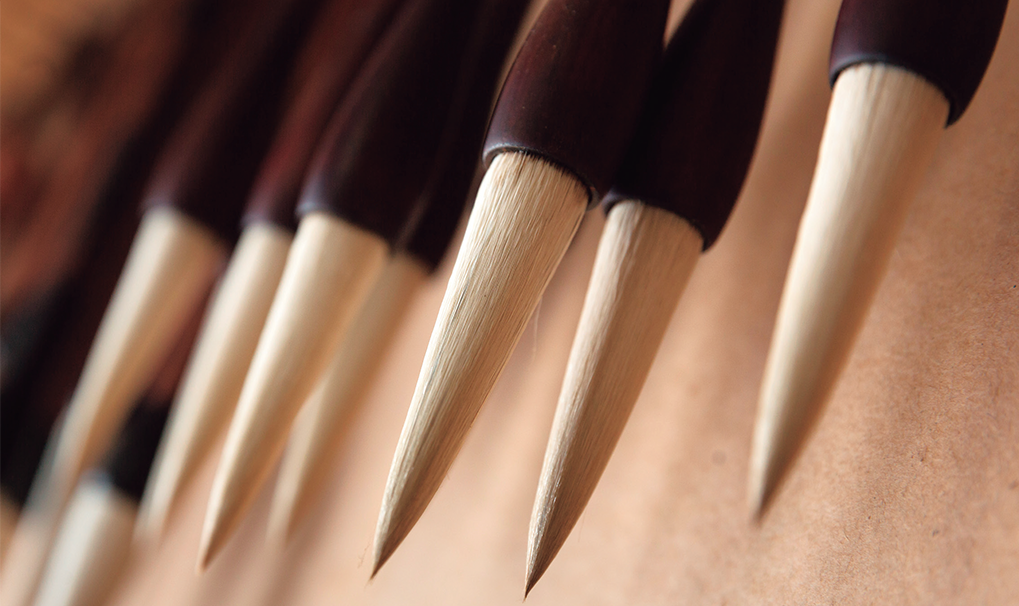
Yu believes that the best brush is versatile for both big and small characters.
Putting His Heart into His Work
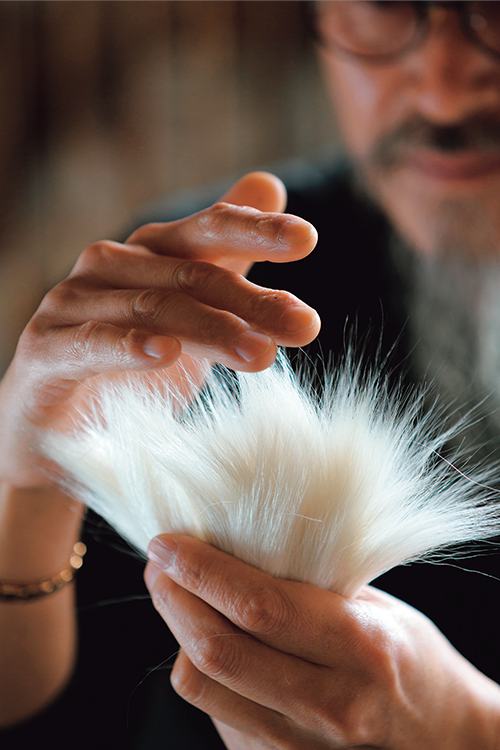
To extend the life of the brushes, Yu uses only the dense, strong part of the hair, cutting away a large portion of the root part with less density.
Yu certainly realizes that few would bother with calligraphy if all brushes were so difficult to use. Aware of this, he has not made any effort to sell his brushes for the last 20 years or so. Having no house or property of his own, he lives at a place provided by a patron free of charge, living and working like a temporary settler. But he has no regrets, for his life is his own choice. He maintains that a brush maker should focus on making brushes and worrying about sales can ruin his work.Whenever he found himself brooding on the matter, he delved deeper into his craft. His commitment growing ever stronger, he ended up expanding his specialty into brush handles as well.
Yu makes handles from scratch, processing the bamboo, engraving rows of characters on the tube, or decorating the length of the body with mother-of-pearl. He also experiments with unprecedented designs, such as a row of peach pits or lotus pips glued together to form a rod. These days, he applies lacquer to the handles to improve durability and even makes racks for his brushes. When asked to choose the brush that he has cherished most over the 40 years of his career, he replied it was impossible because all the brushes he made were so precious to him.
“Each one of my brushes has a story. Some brushes can be explained in half a day, but it can take days to tell the story of others,” he said. “If I didn’t have to worry about making a living, I wouldn’t want to sell any of them. It might be a futile obsession, but over ten years ago, I pledged to sell my brushes only to those who would know their worth. This has also been a motto that has spurred me to persist in the path that I’m on. I tell myself, if it’s not special, it’s not Yu Pil-mu’s brush. That’s why I dare to say that I pour my life into my brushes. I’ve persevered believing that I’llsomething valuable if I put my heart into it, and that people will appreciate it.”
For instance, his brush combined with the Buddhist monk’s wooden block, or moktak, is the outcome of ten years of research. He remembers the time this idea gradually materialized, and how his thoughts kept changing all the while. In creating this unusual writing tool, he was preoccupied with the idea of making “a brush that feels like a part of yourself.” Besides, his rice straw brush with coarse bristles, resembling a broom, also reflects his idea of a brush capable of dynamic s.
“With any project, I always focus on the essential role of each brush. It is up to the user to decide how to use it and for what purposes. It’s absurd and meaningless for me to decide that myself,” said Yu. Then, what does his craft mean to him? As if he had been anticipating the question, he answered immediately: For the first 30 years, he had relied on the brush, but now he often feels that the brush relies on him. It became clear why, despite all his hardships and solitary struggles over decades, his face still showed glimpses of satisfaction and accomplishment